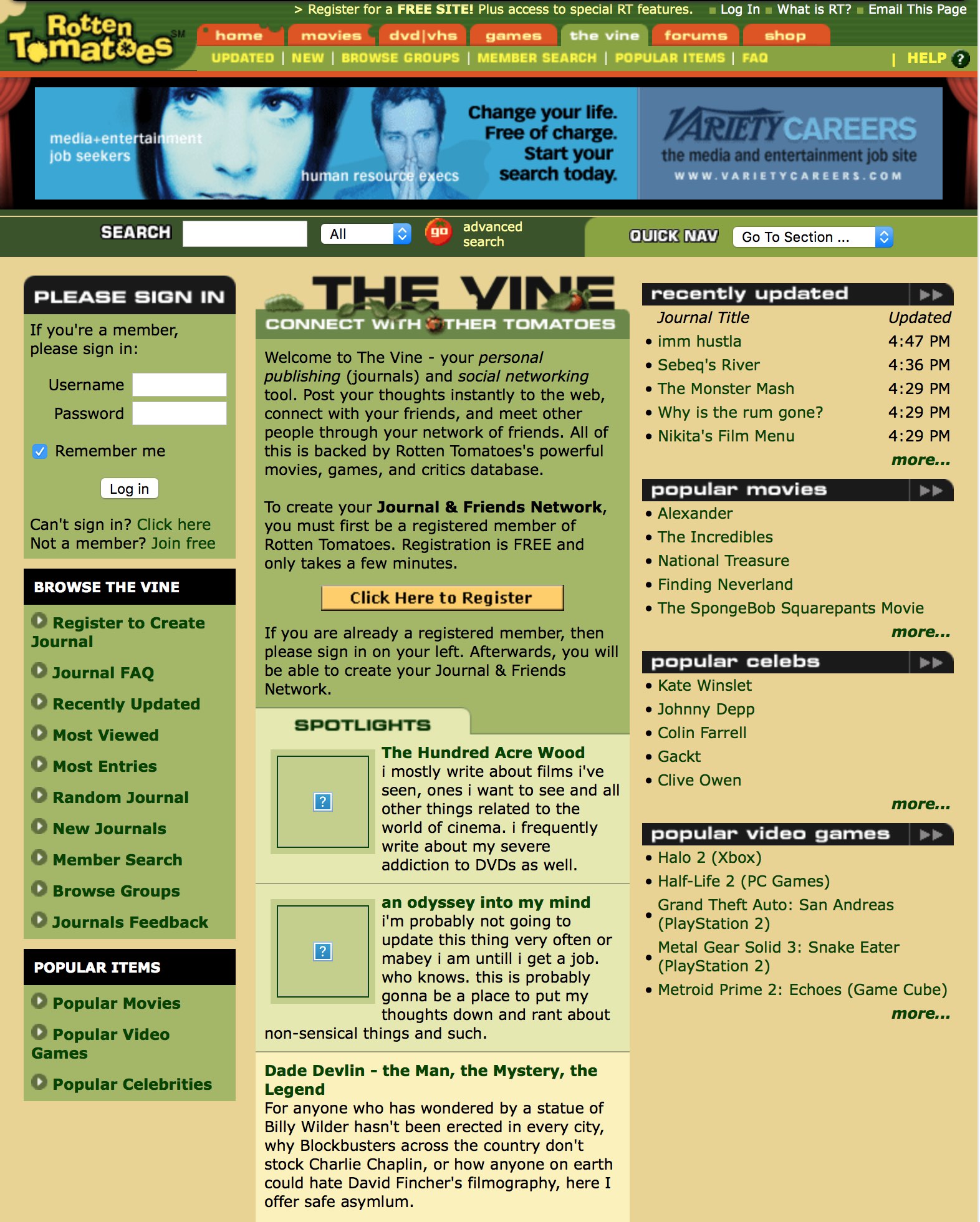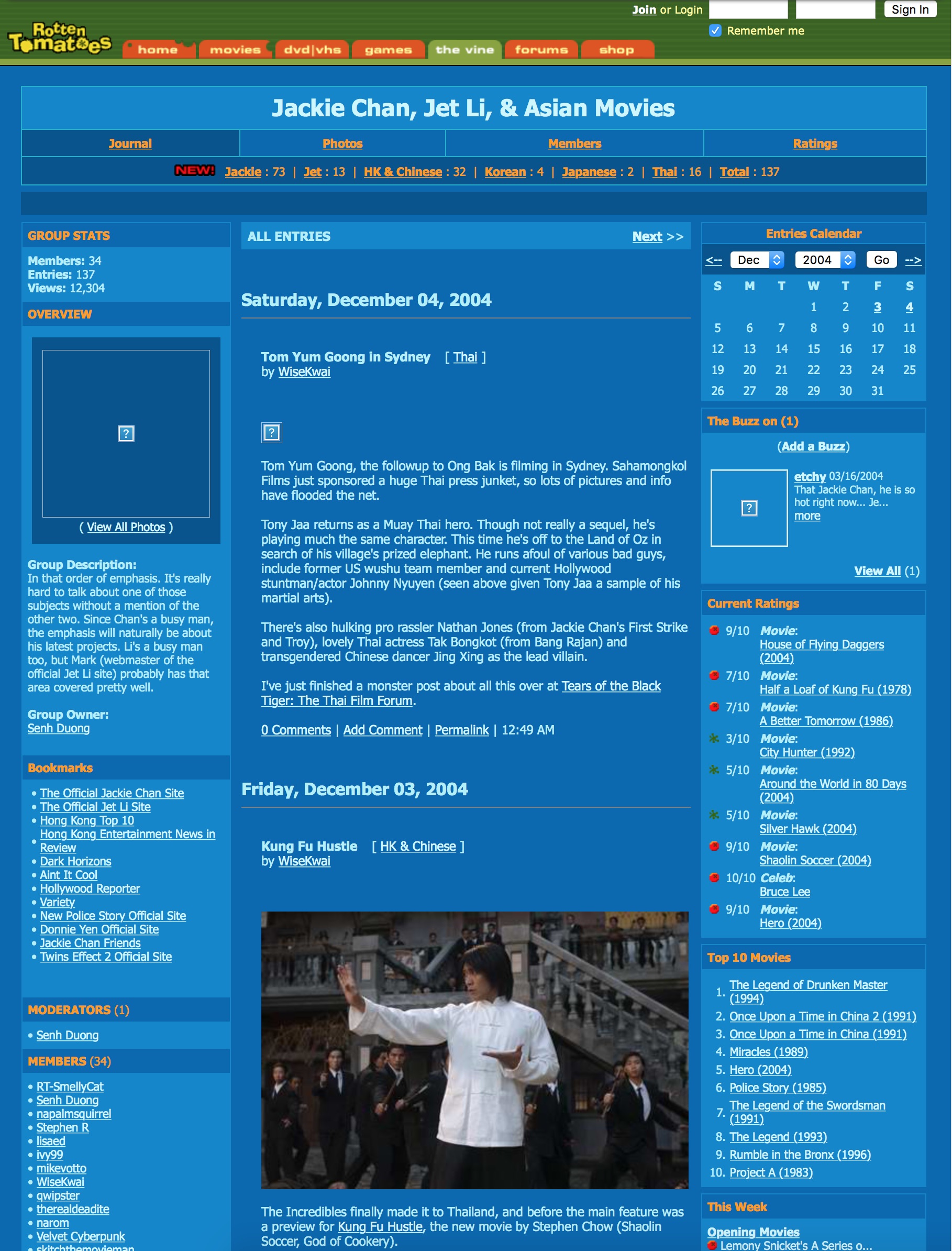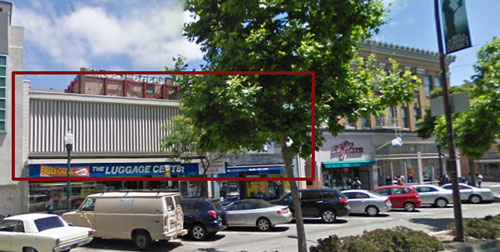I started Design Reactor in June 1997 with my partner Patrick Lee. Design Reactor eventually morphed in to Rotten Tomatoes (same team, same office) which I remained with until 2005 when I moved to China. Here are photos from our original Design Reactor (1997-2000) and Rotten Tomatoes (2000-2005) teams.
Category: Design Reactor
Crazy Rotten Tomatoes Halloween Parties
This is a fourth entry in my retrospective on stories from our early years founding Rotten Tomatoes as part of my #RottenTomatoesTurns20 20th anniversary series.
Most entrepreneur stories generally talk about the various steps of building a team, gaining customers, courting investors, blah blah blah. Certainly I have a lot of those stories, some of which I’ve already written about. However, a lot of my fond nostalgia from Rotten Tomatoes was the sense of closeness we had as a team and many of my memories are those spent with team mates when doing stuff outside of work. Main amongst these would be the Annual Rotten Tomatoes Halloween Party.
Prior to Rotten Tomatoes, Patrick and I had started Design Reactor in 1997, signing the lease for our first office in Berkeley (right above The Luggage Center on Shattuck Avenue) the day after my graduation ceremony. Our initial hiring strategy was basically to ask all of our talented friends at Cal who signed up for more traditional jobs to spend their off-hours doing contract web development and design work for us, folks like Senh Duong, John Joh, Eric Yeh, Walter Wu, Rae Chang, Susan Nakasora, Steven Kam, Derek Sakamoto, Suzanne Wood, Cynthia Sing, and others. Later on, as our Disney work expanded, the company became better established, and we had exhausted our first-line of friends who consisted largely of former dormmates, and fellow nerdy members of the Cal Wushu Team, we then extended further in to friends of friends and a second set of team members, but not too departed from our original networking. Brandon Sugiyama came and joined us from the University of Oregon Wushu Team. Mark Moran was originally from Washington and was practicing wushu in the Bay Area. Again, a lot of Wushu folks. Or friends of employees like Susan Nakasora. We did some rounds of hiring during Design Reactor for folks we didn’t already know but, in the end, it was all Cal grads including Boon Khoo, Michelle Lee, and Emily Lew.
So the story of Rotten Tomatoes is as much about the story about a group of college friends (primarily from Cal, and most with some connection to the Cal Wushu Team and, for the most part, Asian-American) as it is about the struggle to make our place in the film and internet industries. As such, our work environment was pretty atypical with our original office in Berkeley being a hangout spot for lots of our college mates.
Our first taste of success was during 1998 and 1999 at Design Reactor as our web development contracts with the movie studios like Disney and Warner Bros. grew and grew. We thought we’d do something fun after all of the hard work so we threw our first company Halloween party in 1999. Our team weren’t exactly the party experts — our prior experience running big events were for big Wushu-related performances or tournaments. We invited our friends to the party and allowed them to invite their friends but unofficially capped the invitations to just “first and second degree friends”. With our office in Berkeley, we held the party up at the Haas Clubhouse above the Cal campus, but as such it had to be an alcohol-free event. I don’t think any of us were particularly the drinking types back then so this resulted in a pretty tame event that ended prior to midnight.
1999 Design Reactor Halloween Party at Haas Clubhouse
In the subsequent years from 2000-2002 when we had switched over to doing Rotten Tomatoes, we didn’t hold any parties. In April 2000 just as we started doing Rotten Tomatoes full-time, the dotcom bubble popped and by the time Halloween rolled around, I don’t believe anyone was in the mood to celebrate. Similarly, Halloween 2001 was in the shadow of the 9/11 attacks so it would have been inappropriate to have a party. For Halloween 2002, I still remember going with friends to Castro District in costume — up till then, the Castro was the location for the largest street celebrations in the Bay Area, but it was announced that 2002 would be the last year where the city would be doing the celebration in the Castro.
Knowing that we wouldn’t be able to celebrate Halloween in the Castro the following year, Patrick and I decided that we would put on a Rotten Tomatoes Halloween party for our friends just like we had done so for Design Reactor. The same rules were employed as for our first party in 1999 (except this time via Evite): a free party for our first and second degree friends, our company would pay the budget for the venue,decorations, and free first drinks, and, most importantly, wearing a costume was MANDATORY for entry to the party.
The first Rotten Tomatoes Halloween Party had added urgency: In the months leading up to the party, Senh, our senior engineer James Chen, and I had worked hard to develop “The Vine” and we set our deadline for launch as Halloween. “The Vine” was Rotten Tomatoes’ short-lived attempt at doing a social network for movies, music, and video games. We were really influenced by both Friendster and Xanga and wanted to create a place where entertainment fans could share their own movie/music/video game ratings, reviews, and “Top Ten Lists” with others in a blog-like feed format. It was the largest addition to Rotten Tomatoes that we had developed since expanding Rotten Tomatoes to include 80,000+ titles in the early days and we were eager to get it launched and share the new social network with our friends.


Prior to the party in 2003, we were spending many sleepless nights getting The Vine ready and finally launched the feature the day before the Halloween Party.
Exhausted by developing The Vine, we were lucky to have the help of friends from our Cal Wushu Team community to help organize the 2003 party at Mix 26, a bar in the Mission District. Altogether, I believe we had about 300-400 friends show up to our first Rotten Tomatoes Halloween Party and it was the first chance after a long time for the Rotten Tomatoes team and friends to celebrate a bit after several years of arduous work and a challenging business environment.
2003 Annual Rotten Tomatoes Halloween Party at Mix26
Over the following years, the Annual Rotten Tomatoes Halloween Party got larger and larger. We would carry over the invitation list from the previous year and allow prior attendees to invite their first-degree friends which resulted in more and more attendees organically growing year-after-year (kind of like a social network).
In 2004, we moved from a small bar in the Mission over to Suede, a much, much larger nightclub near Fisherman’s Wharf for our second Annual Rotten Tomatoes Halloween Party. By this time, Rotten Tomatoes had been acquired by IGN so we really in the mood to celebrate. Early on in the party, we quickly realized that the party was going to be way more crazy than the year before. I realized that things had kind of gotten out of control when we had the first person pass out drunk in the bathroom by 10pm literally an hour after opening up the door. The line to get into the party at 9pm snaked around the block and I believe we eventually had over 1,000 people attend making it the largest Halloween event in San Francisco that year.
2004 Annual Rotten Tomatoes Halloween Party at Suede
The last Rotten Tomatoes party I helped organize was in 2005. By this time, we had moved to Studio Z (across from DNA Lounge) in the heart of the clubbing area of San Francisco. By this point, our Annual Halloween Party had become a tradition unto itself that was known separately from just Rotten Tomatoes as a company. People were getting elaborate costumes (again, costumes mandatory) prepared almost immediately after the end of the party from the prior year. Each annual Halloween party became larger and more elaborate than the one before.
2005 Annual Rotten Tomatoes Halloween Party at Studio Z
At this last party in 2005, I had already known that I would be leaving Rotten Tomatoes by the end of the year to join Patrick at his startup in China; however, the annual Rotten Tomatoes continued for another two or three years after I left.
The Halloween parties were a way to show our appreciation for all of our friends who had supported the Design Reactor and Rotten Tomatoes team through the years. We all started out as college buddies and Halloween gave us all an excuse to celebrate and dress up in elaborate, movie-related costumes. The legacy of the Rotten Tomatoes Halloween parties hold a fond place in my memory as important to me as the war stories about doing business or developing tech.
Special thanks to Brandon Sugiyama, Kevin Morris, and James Yang, the three amigos who helped us every year to throw these awesome parties.
Postscript: After Rotten Tomatoes, Patrick and I moved to Asia where we did another company, alivenotdead.com, a social network for celebrities and artists in Asia. In 2008, alivenotdead held it’s first “Dead Not Alive Halloween Party”. Just like the Rotten Tomatoes Halloween Party, the party was also “costumes mandatory” and initially done as a celebration to thank our friends. Over the years, however, the “Dead Not Alive Halloween Party” has grown in to an annual event much larger than anything that we ever did under Rotten Tomatoes — a commercial success unto itself and the most popular Halloween party in Hong Kong largely due to the tireless efforts of Raffi Kamalian who attended many of our prior Halloween Parties in the Bay Area. It’s hard to believe that we just celebrated the 10th Annual Halloween Party here in Asia but, believe it or not, the roots for this annual extravaganza runs all the way back to that first alcohol-free on-campus Halloween Party we threw for our friends in 1999.
For more of my Rotten Tomatoes 20th anniversary articles, check out my other memories.
Design Reactor (1997-2000)
Note: This post is part of an extended auto-biography which is collected in my About page.
Late in my senior year of college in 1997, I met with Patrick Lee, a college classmate who had similarly started a growing start-up (Human Ingenuity) and had hired Go! Designs to create his company’s web site. We had discussions about how we might be able to expand the web design work we were doing at Go! Designs. As a result, Patrick and I left our respective startups and forming a new partnership, Design Reactor. The first day after my graduation, we sealed our commitment by signing a lease to a new office on 2223 Shattuck Avenue in Berkeley and got to work assembling a small army of designers and engineers from amongst our talented group of college classmates to expand the scope and scale of our web design work.

During our first year, despite a slow beginning completing low-cost web design work for local tech companies, we were able to break the barrier and land The Disney Channel as a major client. Over the next two years, we were able to grow our relationship with Disney to become the primary web design firm for the Disney/ABC TV Networks as well as designing various Walt Disney Studios official movie web sites.
As the primary client manager for Disney/ABC, I’m most proud of the work we did to create and operate the online portion of Zoog Disney, the primary programming block on The Disney Channel and also Disney’s first foray into online, on-air synergy. The award-winning ZoogDisney.com was an ambitious web site for kids to connect with their favorite Disney Channel TV shows. While producing the ZoogDisney.com, we developed web sites for all of the Disney Channel TV shows and over 120 web-based games where kids’ fan messages and game hi-scores were posted each week on-air on The Disney Channel.
Other highlights of our work for Disney included creating ToonDisney.com, the official web site for Disney’s all Disney cartoon cable channel. As a measure of Disney’s trust in Design Reactor, we were the first web design firm permitted to animate the Disney’s Fab Five cartoon characters (i.e. Mickey, Minnie, Donald, Goofy, and Pluto) online. Our work for Disney eventually resulted in us also becoming the primary web vendor for ABC. At ABC, we created the “Who Wants to Be Millionaire?” Online Game which, at the time, was one of the most heavily-played games online, as well as managed the official Oscar.com web site for the Academy Awards in 2000.
Despite requiring me to split my time between our Design Reactor team in the San Francisco Bay Area and the Disney Channel/Disney.com offices in Los Angeles, I really enjoyed my time building some really enjoyable web destinations and games for such a great client and feel blessed being entrusted with the large responsibility at such a young age.
Our close relationship with Disney provided us with the chance to grow Design Reactor to a team of 28 people and we were able to dedicate ourselves to becoming one of the premier web design firms in the entertainment industry. Here are some of the other fun projects that we worked on:
- Leveraging the success with Disney, we were able to eventually work with many additional film studios (Warner Bros., Universal, Fox, Sony, Artisan Entertainment) to produce official web sites for many films.
- Working with Warner Bros. Online, we participated in their “Entertaindom” project, WB’s first foray into original online web programming. We produced two original web series for WB including a Flash-based cartoon series we wrote with character design by the head animator of WB’s “The Animaniacs”.
- My business partner, Patrick, and I originally had met in college as members of the Cal Wushu Team. Wushu is Chinese martial arts whose most famous practitioner is actor Jet Li. As a result, in 1999 we fulfilled our dream of meeting Jet in-person and were commissioned to create and manage his Official Web Site. Created as Jet was first entering Hollywood films, the web site allowed Jet to connect and grow a global community of fans and share his unique life perspective and philosophy. Even after departing Design Reactor, we continue to work with Jet and his various efforts online including his Official Web Site.
As one of the leading web design firms in the entertainment industry, Design Reactor gave me the opportunity to play a role in the emerging connection between entertainment and the Internet at a really young age and a chance to immediately work post-graduation with a great circle of smart friends and classmates from Berkeley.



























































